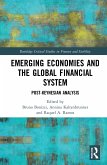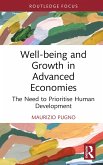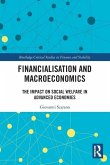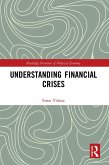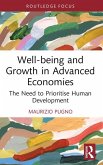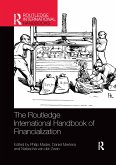Emerging Economies and the Global Financial System
Post-Keynesian Analysis
Herausgeber: Bonizzi, Bruno; A. Ramos, Raquel; Kaltenbrunner, Annina
Emerging Economies and the Global Financial System
Post-Keynesian Analysis
Herausgeber: Bonizzi, Bruno; A. Ramos, Raquel; Kaltenbrunner, Annina
- Gebundenes Buch
- Merkliste
- Auf die Merkliste
- Bewerten Bewerten
- Teilen
- Produkt teilen
- Produkterinnerung
- Produkterinnerung
This book provides a comprehensive overview of the financial integration of emerging economies through an in-depth analysis of the international monetary system, how it impacts capital flows and exchange rates, and its implications for policy making.
Andere Kunden interessierten sich auch für
![Emerging Economies and the Global Financial System Emerging Economies and the Global Financial System]() Emerging Economies and the Global Financial System43,99 €
Emerging Economies and the Global Financial System43,99 €![Financialisation in Emerging Economies Financialisation in Emerging Economies]() Juan Pablo PainceiraFinancialisation in Emerging Economies45,99 €
Juan Pablo PainceiraFinancialisation in Emerging Economies45,99 €![Well-being and Growth in Advanced Economies Well-being and Growth in Advanced Economies]() Maurizio Pugno (University of Cassino and Italy Southern Lazio)Well-being and Growth in Advanced Economies66,99 €
Maurizio Pugno (University of Cassino and Italy Southern Lazio)Well-being and Growth in Advanced Economies66,99 €![Financialization and Macroeconomics Financialization and Macroeconomics]() Giovanni ScaranoFinancialization and Macroeconomics51,99 €
Giovanni ScaranoFinancialization and Macroeconomics51,99 €![Understanding Financial Crises Understanding Financial Crises]() Ensar YilmazUnderstanding Financial Crises47,99 €
Ensar YilmazUnderstanding Financial Crises47,99 €![Well-being and Growth in Advanced Economies Well-being and Growth in Advanced Economies]() Maurizio PugnoWell-being and Growth in Advanced Economies22,99 €
Maurizio PugnoWell-being and Growth in Advanced Economies22,99 €![The Routledge International Handbook of Financialization The Routledge International Handbook of Financialization]() The Routledge International Handbook of Financialization51,99 €
The Routledge International Handbook of Financialization51,99 €-
-
-
This book provides a comprehensive overview of the financial integration of emerging economies through an in-depth analysis of the international monetary system, how it impacts capital flows and exchange rates, and its implications for policy making.
Produktdetails
- Produktdetails
- Routledge Critical Studies in Finance and Stability
- Verlag: Taylor & Francis Ltd
- Seitenzahl: 292
- Erscheinungstermin: 5. Mai 2021
- Englisch
- Abmessung: 240mm x 161mm x 20mm
- Gewicht: 606g
- ISBN-13: 9780367111427
- ISBN-10: 036711142X
- Artikelnr.: 60019781
- Herstellerkennzeichnung
- Libri GmbH
- Europaallee 1
- 36244 Bad Hersfeld
- gpsr@libri.de
- Routledge Critical Studies in Finance and Stability
- Verlag: Taylor & Francis Ltd
- Seitenzahl: 292
- Erscheinungstermin: 5. Mai 2021
- Englisch
- Abmessung: 240mm x 161mm x 20mm
- Gewicht: 606g
- ISBN-13: 9780367111427
- ISBN-10: 036711142X
- Artikelnr.: 60019781
- Herstellerkennzeichnung
- Libri GmbH
- Europaallee 1
- 36244 Bad Hersfeld
- gpsr@libri.de
Bruno Bonizzi is a Senior Lecturer in Finance at the University of Hertfordshire, Business School, UK. Annina Kaltenbrunner is Associate Professor in the Economics of Globalisation and the International Economy at Leeds University Business School, UK. Raquel A. Ramos is a Research Associate at the Centre d'Économie de l'Université Paris Nord, France.
Part I. Introduction and Background 1. Introduction 2. Two Post-Keynesian
approaches to international finance: the compensation thesis and the
cambist view 3. Trade versus capital flows: the key implicit and
methodological differences between the neoclassical and the Post Keynesian
approaches to exchange rate determination PART II. Minsky, balance sheets
and cycles 4. A Minskyan framework for the analysis of financial flows to
emerging economies 5. Post Keynesian and structuralist approaches to
boom-bust cycles in emerging economies 6. Cost competitiveness and asset
prices as determinants of the current account in emerging economies 7.
Space in Post Keynesian monetary economics: an exploration of the
literature PART III. Currency Hierarchy 8. Evolving international monetary
and financial architecture and the development challenge: a liquidity
preference theoretical perspective 9. International money, privileges and
underdevelopment 10. The Post Keynesian View on Exchange Rates: towards the
consolidation of the different contributions in the ABM and SFC frameworks
11. A Post Keynesian framework for real exchange rate determination: an
overview Part IV. Current Account and Growth 12. The Kaleckian theory of
exchange rates 13. Financial liberalisation, exchange rate dynamics and the
financial Dutch disease in developing and emerging economies 14. Global
financial flows in Kaleckian models of growth and distribution: a survey
Part V. Policy Implications 15. Implications of Modern Money Theory on
Development Finance 16. Monetary sovereignty in the Post Keynesian
perspective: in the search of a concept 17. Dealing with global financial
asymmetry: Contributions of Regional Monetary Cooperation Between Emerging
Markets and Developing Countries 18. De-regulation of Finance in China and
India: a Post Keynesian Analysis
approaches to international finance: the compensation thesis and the
cambist view 3. Trade versus capital flows: the key implicit and
methodological differences between the neoclassical and the Post Keynesian
approaches to exchange rate determination PART II. Minsky, balance sheets
and cycles 4. A Minskyan framework for the analysis of financial flows to
emerging economies 5. Post Keynesian and structuralist approaches to
boom-bust cycles in emerging economies 6. Cost competitiveness and asset
prices as determinants of the current account in emerging economies 7.
Space in Post Keynesian monetary economics: an exploration of the
literature PART III. Currency Hierarchy 8. Evolving international monetary
and financial architecture and the development challenge: a liquidity
preference theoretical perspective 9. International money, privileges and
underdevelopment 10. The Post Keynesian View on Exchange Rates: towards the
consolidation of the different contributions in the ABM and SFC frameworks
11. A Post Keynesian framework for real exchange rate determination: an
overview Part IV. Current Account and Growth 12. The Kaleckian theory of
exchange rates 13. Financial liberalisation, exchange rate dynamics and the
financial Dutch disease in developing and emerging economies 14. Global
financial flows in Kaleckian models of growth and distribution: a survey
Part V. Policy Implications 15. Implications of Modern Money Theory on
Development Finance 16. Monetary sovereignty in the Post Keynesian
perspective: in the search of a concept 17. Dealing with global financial
asymmetry: Contributions of Regional Monetary Cooperation Between Emerging
Markets and Developing Countries 18. De-regulation of Finance in China and
India: a Post Keynesian Analysis
Part I. Introduction and Background 1. Introduction 2. Two Post-Keynesian
approaches to international finance: the compensation thesis and the
cambist view 3. Trade versus capital flows: the key implicit and
methodological differences between the neoclassical and the Post Keynesian
approaches to exchange rate determination PART II. Minsky, balance sheets
and cycles 4. A Minskyan framework for the analysis of financial flows to
emerging economies 5. Post Keynesian and structuralist approaches to
boom-bust cycles in emerging economies 6. Cost competitiveness and asset
prices as determinants of the current account in emerging economies 7.
Space in Post Keynesian monetary economics: an exploration of the
literature PART III. Currency Hierarchy 8. Evolving international monetary
and financial architecture and the development challenge: a liquidity
preference theoretical perspective 9. International money, privileges and
underdevelopment 10. The Post Keynesian View on Exchange Rates: towards the
consolidation of the different contributions in the ABM and SFC frameworks
11. A Post Keynesian framework for real exchange rate determination: an
overview Part IV. Current Account and Growth 12. The Kaleckian theory of
exchange rates 13. Financial liberalisation, exchange rate dynamics and the
financial Dutch disease in developing and emerging economies 14. Global
financial flows in Kaleckian models of growth and distribution: a survey
Part V. Policy Implications 15. Implications of Modern Money Theory on
Development Finance 16. Monetary sovereignty in the Post Keynesian
perspective: in the search of a concept 17. Dealing with global financial
asymmetry: Contributions of Regional Monetary Cooperation Between Emerging
Markets and Developing Countries 18. De-regulation of Finance in China and
India: a Post Keynesian Analysis
approaches to international finance: the compensation thesis and the
cambist view 3. Trade versus capital flows: the key implicit and
methodological differences between the neoclassical and the Post Keynesian
approaches to exchange rate determination PART II. Minsky, balance sheets
and cycles 4. A Minskyan framework for the analysis of financial flows to
emerging economies 5. Post Keynesian and structuralist approaches to
boom-bust cycles in emerging economies 6. Cost competitiveness and asset
prices as determinants of the current account in emerging economies 7.
Space in Post Keynesian monetary economics: an exploration of the
literature PART III. Currency Hierarchy 8. Evolving international monetary
and financial architecture and the development challenge: a liquidity
preference theoretical perspective 9. International money, privileges and
underdevelopment 10. The Post Keynesian View on Exchange Rates: towards the
consolidation of the different contributions in the ABM and SFC frameworks
11. A Post Keynesian framework for real exchange rate determination: an
overview Part IV. Current Account and Growth 12. The Kaleckian theory of
exchange rates 13. Financial liberalisation, exchange rate dynamics and the
financial Dutch disease in developing and emerging economies 14. Global
financial flows in Kaleckian models of growth and distribution: a survey
Part V. Policy Implications 15. Implications of Modern Money Theory on
Development Finance 16. Monetary sovereignty in the Post Keynesian
perspective: in the search of a concept 17. Dealing with global financial
asymmetry: Contributions of Regional Monetary Cooperation Between Emerging
Markets and Developing Countries 18. De-regulation of Finance in China and
India: a Post Keynesian Analysis


